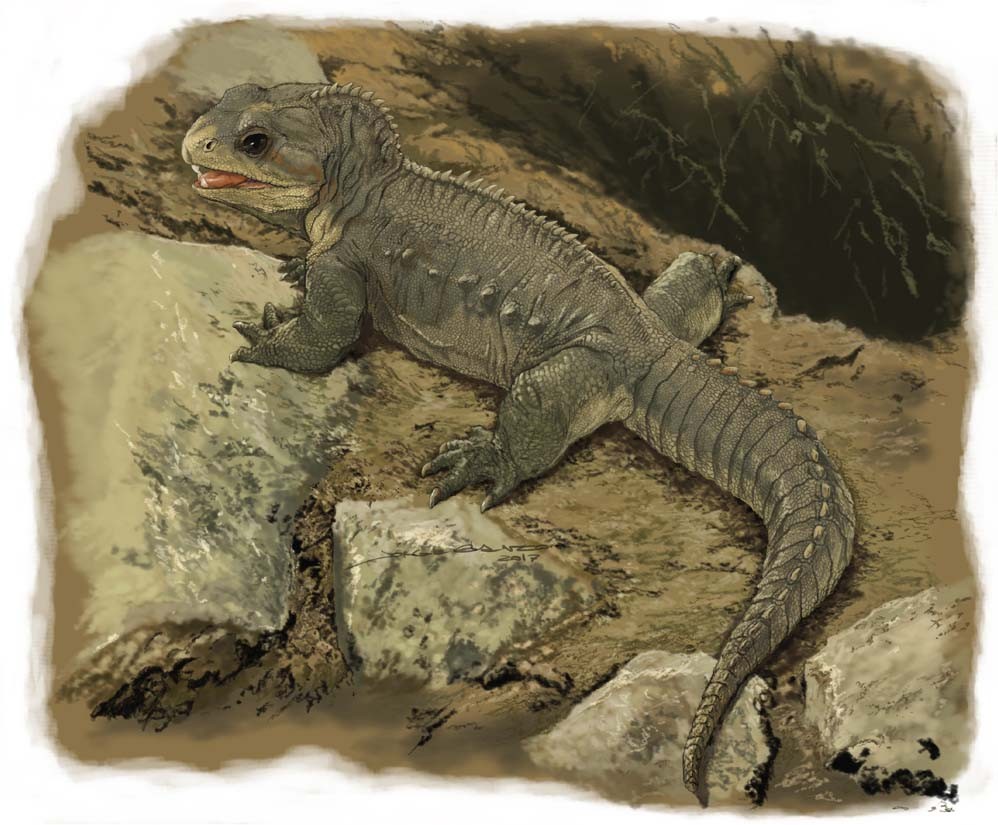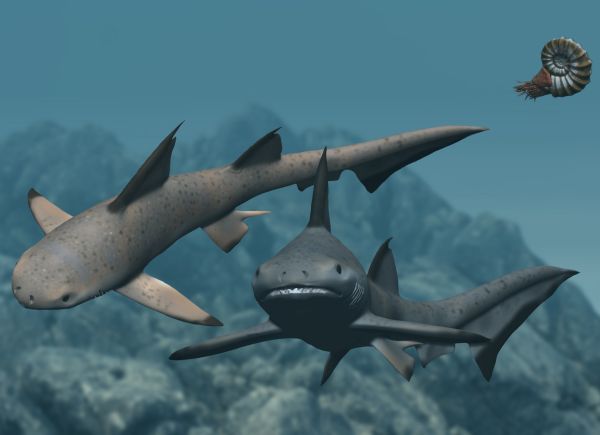|
Clevosaurus
''Clevosaurus'' (meaning "Gloucester lizard") is an extinct genus of rhynchocephalian reptile from the Late Triassic and the Early Jurassic periods. Species of ''Clevosaurus'' were widespread across Pangaea, and have been found on all continents except Australia and Antarctica. Five species of ''Clevosaurus'' have been found in ancient fissure fill deposits in south-west England and Wales, alongside other sphenodontians, early mammals and dinosaurs. In regards to its Pangaean distribution, ''C. hadroprodon'' is the oldest record of a sphenodontian from Gondwana, though its affinity to ''Clevosaurus'' has been questioned. History of discovery The first species of ''Clevosaurus'' to be described was ''C. hudsoni'', which was described by William Elgin Swinton in 1939 from a fissure fill deposit in Cromhall Quarry ( Magnesian Conglomerate Formation) in the county of Gloucestershire, England, with the name of the county lending its name to the genus. Description ''Clevosaurus' ... [...More Info...] [...Related Items...] OR: [Wikipedia] [Google] [Baidu] |
Clevosauridae
Clevosaurs are an extinct group of rhynchocephalian reptiles from the Triassic and Jurassic periods. History and definition Although members of this group have been known since 1910, only recently has the group received a formal name. In the late 1990s, Victor-Hugo Reynoso established that three particular genera of Sphenodontia ('' Clevosaurus, Brachyrhinodon'', and '' Polysphenodon'') were closely related to each other. He gave the informal name "clevosaurs" to these three genera, after the most numerous and well-known genus, ''Clevosaurus.'' He considered clevosaurs to be members of the family Sphenodontidae, the family of rhynchocephalians containing the only living member of the order, the tuatara (''Sphenodon).'' In 2006, Bonaparte and Sues finally gave "clevosaurs" a formal name and taxonomic rank as the family Clevosauridae. They defined Clevosauridae as the last common ancestor of ''Clevosaurus, Brachyrhinodon,'' and ''Polysphenodon,'' and all of its descendants. In ... [...More Info...] [...Related Items...] OR: [Wikipedia] [Google] [Baidu] |
Rhynchocephalia
Rhynchocephalia (; ) is an order of lizard-like reptiles that includes only one living species, the tuatara (''Sphenodon punctatus'') of New Zealand. Despite its current lack of diversity, during the Mesozoic rhynchocephalians were a diverse group including a wide array of morphologically distinct forms. The oldest record of the group is dated to the Middle Triassic around 238 to 240 million years ago, and they had achieved a worldwide distribution by the Early Jurassic. Most rhynchocephalians belong to the group Sphenodontia ('wedge-teeth'). Their closest living relatives are lizards and snakes in the order Squamata, with the two orders being grouped together in the superorder Lepidosauria. Many of the niches occupied by lizards today were held by sphenodontians during the Triassic and Jurassic, although lizard diversity began to overtake sphenodontian diversity in the Cretaceous, and they had disappeared almost entirely by the beginning of the Cenozoic. While the modern tuat ... [...More Info...] [...Related Items...] OR: [Wikipedia] [Google] [Baidu] |
Pant-y-Ffynnon Quarry
Pant-y-Ffynnon Quarry is a stone quarry in the Vale of Glamorgan, Wales, around 3 kilometers east of Cowbridge. It contains fissure fill deposits dating to the Late Triassic (Rhaetian), hosted within karsts of Carboniferous aged limestone, primarily the Friars Point Limestone Formation. Remains of numerous small vertebrates, notably archosaurs, are known from the fissure fills in the quarry, similar to other Late Triassic-Early Jurassic fissure fill deposits known from Southwest England and southern Wales. History The quarry was likely in use since at least the 1910s, and the first fossil specimens discovered at the quarry were collected by palaeontologists Kenneth Kermack and Pamela Robinson of University College London , mottoeng = Let all come who by merit deserve the most reward , established = , type = Public research university , endowment = £143 million (2020) , budget = � ... bet ... [...More Info...] [...Related Items...] OR: [Wikipedia] [Google] [Baidu] |
Santa Maria Formation
The Santa Maria Formation is a sedimentary rock formation found in Rio Grande do Sul, Brazil. It is primarily Carnian in age ( Late Triassic), and is notable for its fossils of cynodonts, " rauisuchian" pseudosuchians, and early dinosaurs and other dinosauromorphs, including the herrerasaurid ''Staurikosaurus'', the basal sauropodomorphs '' Buriolestes'' and ''Saturnalia,'' and the lagerpetid '' Ixalerpeton''. The formation is named after the city of Santa Maria in the central region of Rio Grande do Sul, where outcrops were first studied. The Santa Maria Formation makes up the majority of the Santa Maria Supersequence, which extends through the entire Late Triassic. The Santa Maria Supersequence is divided into four geological sequences, separated from each other by short unconformities. The first two of these sequences (Pinheiros-Chiniquá and Santa Cruz sequences) lie entirely within the Santa Maria Formation, while the third (the Candelária sequence) is shared with ... [...More Info...] [...Related Items...] OR: [Wikipedia] [Google] [Baidu] |
Lufeng Formation
The Lufeng Formation (formerly Lower Lufeng Series) is a Lower Jurassic sedimentary rock formation found in Yunnan, China. It has two units: the lower Dull Purplish Beds/Shawan Member are of Hettangian age, and Dark Red Beds/Zhangjia'ao Member are of Sinemurian age.Luo, Z., and X.-C. Wu. 1994. The small tetrapods of the Lower Lufeng Formation, Yunnan, China; pp. 251–270 in N. C. Fraser and H.-D.Sues (eds.), In the Shadow of the Dinosaurs. Cambridge University Press, New York It is known for its fossils of early dinosaurs. The Dull Purplish Beds have yielded the possible therizinosaur '' Eshanosaurus'', the possible theropod ''Lukousaurus'', and the "prosauropods" "Gyposaurus" ''sinensis'', '' Lufengosaurus'', '' Jingshanosaurus'', and '' Yunnanosaurus''. Dinosaurs discovered in the Dark Red Beds include the theropod ''Sinosaurus triassicus'', the "prosauropods" "Gyposaurus", ''Lufengosaurus'', and ''Yunnanosaurus'', indeterminate remains of sauropods, and the early arm ... [...More Info...] [...Related Items...] OR: [Wikipedia] [Google] [Baidu] |
Caturrita Formation
The Caturrita Formation is a rock formation found in Rio Grande do Sul, Brazil. Its sediments were deposited in the Paraná Basin. The formation is from the Upper Triassic and forms part of the Santa Maria Supersequence in the upper section of the Rosário do Sul Group. Etymology The formation received this name, because Caturrita is a neighbourhood (barrio) of Santa Maria. In Portuguese ''caturrita'' also refers to the monk parakeet. Stratigraphy The sediments of the Caturrita Formation belong to the second unit of the Santa Maria Supersequence and overlie the Alemoa Member of the Santa Maria Formation. The clayey sediments of the Alemoa Member gradually give way to the more sandy, rarely conglomeratic, Caturrita Formation, which finishes with an unconformity. After this erosional event follow the Rhaetian sediments of the Mata Sandstone, the third unit of the Santa Maria Supersequence. The Caturrita Formation was once regarded as a member of the stratigraphically higher B ... [...More Info...] [...Related Items...] OR: [Wikipedia] [Google] [Baidu] |
McCoy Brook Formation
The McCoy Brook Formation is a geological formation dating to roughly between 200 and 190 million years ago and covering the Hettangian to Sinemurian stages. The McCoy Brook Formation is found in outcrops around the Bay of Fundy, Nova Scotia. Agen The McCoy Brook Formation rests on the North Mountain Basalt, one of the volcanic flows associated with the Triassic–Jurassic boundary in the Newark Supergroup. The base of the McCoy Brook Formation is probably within 100,000 to 200,000 years of the boundary. Scots Bay Member This thin unit (9 m) of lacustrine sediments is preserved in six small synclinal outcrops around Scots Bay on the west side of the Blomidon Peninsula. Originally named as the ''Scots Bay Formation'', it is now correlated with the lowermost part of the McCoy Brook Formation, where it is referred to as the ''Scots Bay Member''. Fossil content Sharks Ray-finned fish Synapsids Sphenodonts Crocodyliforms Dinosaurs Ornithischia Saur ... [...More Info...] [...Related Items...] OR: [Wikipedia] [Google] [Baidu] |
Pangaea
Pangaea or Pangea () was a supercontinent that existed during the late Paleozoic and early Mesozoic eras. It assembled from the earlier continental units of Gondwana, Euramerica and Siberia during the Carboniferous approximately 335 million years ago, and began to break apart about 200 million years ago, at the end of the Triassic and beginning of the Jurassic. In contrast to the present Earth and its distribution of continental mass, Pangaea was centred on the equator and surrounded by the superocean Panthalassa and the Paleo-Tethys and subsequent Tethys Oceans. Pangaea is the most recent supercontinent to have existed and the first to be reconstructed by geologists. Origin of the concept The name "Pangaea" is derived from Ancient Greek ''pan'' (, "all, entire, whole") and ''Gaia'' or Gaea (, "Mother Earth, land"). The concept that the continents once formed a contiguous land mass was hypothesised, with corroborating evidence, by Alfred Wegener, the originator of ... [...More Info...] [...Related Items...] OR: [Wikipedia] [Google] [Baidu] |
Rhaetian
The Rhaetian is the latest age of the Triassic Period (in geochronology) or the uppermost stage of the Triassic System (in chronostratigraphy). It was preceded by the Norian and succeeded by the Hettangian (the lowermost stage or earliest age of the Jurassic). The base of the Rhaetian lacks a formal GSSP, though candidate sections include Steinbergkogel in Austria (since 2007) and Pignola-Abriola in Italy (since 2016). The end of the Rhaetian (and the base of the overlying Hettangian Stage) is more well-defined. According to the current ICS (International Commission on Stratigraphy) system, the Rhaetian ended ± 0.2 Ma ( million years ago). In 2010, the base of the Rhaetian (i.e. the Norian-Rhaetian boundary) was voted to be defined based on the first appearance of '' Misikella posthernsteini'', a marine conodont. However, there is still much debate over the age of this boundary, as well as the evolution of ''M. posthernsteini''. The most comprehensive source of precise ... [...More Info...] [...Related Items...] OR: [Wikipedia] [Google] [Baidu] |
Phylogenetic Analysis
In biology Biology is the scientific study of life. It is a natural science with a broad scope but has several unifying themes that tie it together as a single, coherent field. For instance, all organisms are made up of cells that process hereditar ..., phylogenetics (; from Greek language, Greek wikt:φυλή, φυλή/wikt:φῦλον, φῦλον [] "tribe, clan, race", and wikt:γενετικός, γενετικός [] "origin, source, birth") is the study of the evolutionary history and relationships among or within groups of organisms. These relationships are determined by Computational phylogenetics, phylogenetic inference methods that focus on observed heritable traits, such as DNA sequences, Protein, protein Amino acid, amino acid sequences, or Morphology (biology), morphology. The result of such an analysis is a phylogenetic tree—a diagram containing a hypothesis of relationships that reflects the evolutionary history of a group of organisms. The tips of a ... [...More Info...] [...Related Items...] OR: [Wikipedia] [Google] [Baidu] |


_601758.jpg)






